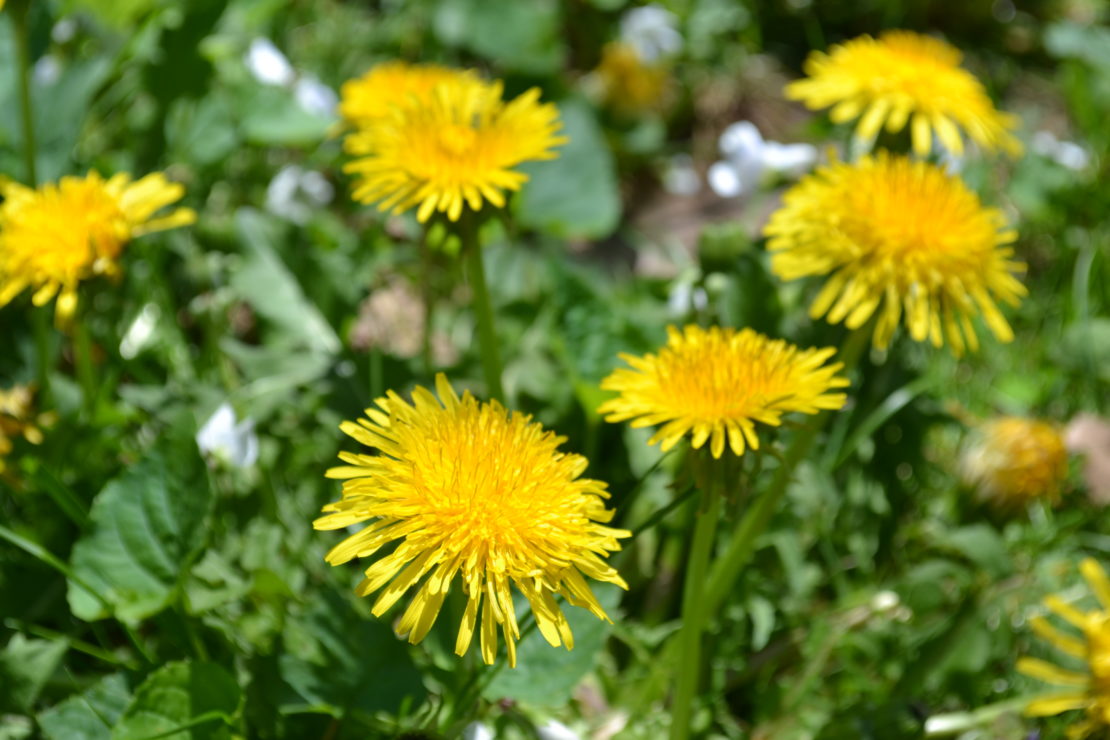
All About Dandelion (For Your Materia Medica)
Dandelion (Taraxacum officinale) is most assuredly a treasured plant in my local materia medica and is appreciated by herbalists throughout temperate regions of the world. Sadly, dandelion is not celebrated by all—due to its penchant to grow and blossom wherever it darn well pleases, it is loathed and poisoned by those who value a pristine green carpet of lawn. What a pity (and quite the irony) as dandelion is one of the very herbs that can help our bodies deal with the modern load of chemicals in our food, air, water, and soil. Let’s learn more about dandelion below!
Identifying Dandelion
Most of us are familiar with dandelion’s sunny yellow flowers consisting of a collection, or composite, of many individual ray florets. Indeed, dandelion is a member of the Compositae family, now called Asteraceae. The notches at the end of each ray floret are actually each a petal, and the ray becomes a nectar-filled tube at the ovary (Johnston, n.d.). Also visible amidst the ray florets is the fine white fibers (pappus, plural pappi) that connect to the ovules and become the fluffy white sails that carry the seeds on the wind.
The leaves and hollow flower stems grow from a basal rosette. The smooth dark green leaves are deeply toothed at their edges, the tips of the jagged teeth pointing back towards the center of the rosette. The French name for dandelion is “dent de lion” or “tooth of the lion” (Blair, 2014).
Dandelion roots grow as taproots with a brown exterior and white interior. The roots (and the stems) contain a milky latex. This latex contains a bitter sesquiterpene lactone that fends off insect predators, thus protecting the nutrients stored in the roots (Phys.org, 2016).
Note there are some dandelion look-alikes such as cat’s ear (Hypochoeris radicata), hawkweed (Hieracium pilosella), young wild lettuce (Lactuca spp.) plants, and sow thistle (Sonchus spp.) (Tilford, 1997; Virginia Tech, n.d., Edible Wild Food, n.d.). Note that dandelion differs from these plants in that it only has one flower per stem (no branching stems), has a hollow stem containing milky latex, and is not hairy. Cat’s ear and hawkweed, for example are both hairy and have multiple flowers per stem on branched, solid stems.
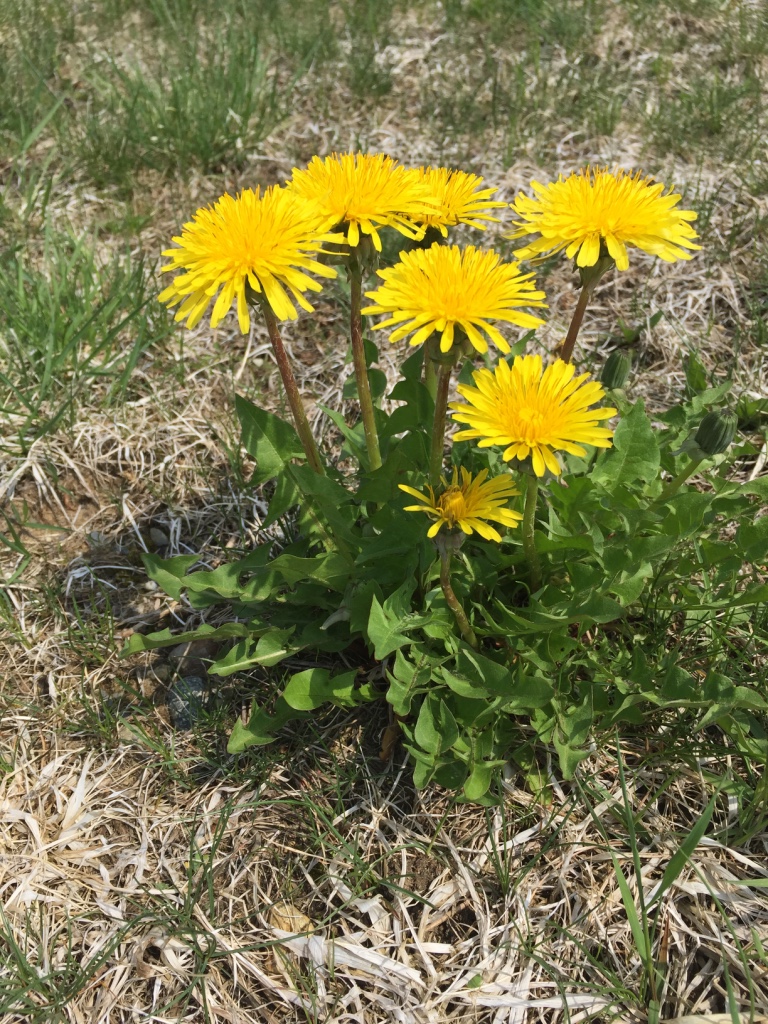
Dandelion Is Edible
All parts of the dandelion are edible and nutritious, from flower to root! Dandelion leaf is high in vitamins A and C, potassium, calcium, iron, phosphorus, and B-vitamins, while dandelion root is high in protein, iron, manganese, phosphorus, and vitamin A (Pedersen, 2010; Weed, 1989).
The flowers can be dipped in batter and fried to make delicious fritters or the ray florets can be pulled off and sprinkled in salads, added to baked goods, or used to make a delicious flower syrup. The leaves can be enjoyed as sauteed greens, in frittatas and soups, or fresh in salads and pestos. The roots are a popular coffee substitute when roasted and are great in a digestive bitter to take before a meal. They can be made into tea as an herbal decoction or infused to make a dandelion vinegar for salad dressings.

Harvesting Dandelion
I often just simply pick a few leaves each day in the garden and eat them fresh, or gather a few handfuls to toss in a salad. Tender spring leaves are less bitter than mid-summer and fall leaves; although any newly unfurled leaves will be less bitter (and you’ll learn below that bitter is not a bad thing!).
Roots can be harvested in spring and autumn, with spring-harvested roots more bitter and autumn-harvested roots sweeter due to the storage of nutrients throughout the growing season. Autumn-harvested roots also contain more of the polysaccharide inulin, a soluble fiber that feeds beneficial gut bacteria (Murray & Pizzorno, 2005).
Dandelion Pesto
Adapted from The Wild Wisdom of Weeds by Katrina Blair
2 cups fresh young dandelion greens
1 cup basil
1 cup cashews, almonds, or pine nuts
½ cup olive oil
1 cup water
3 tablespoons lemon juice
3 cloves garlic
1 teaspoon salt
- Wash and dry dandelion greens and basil.
- Combine all ingredients in a blender or food processor and blend until smooth and creamy.
- Serve as a dip with vegetable crudites or crackers, on pasta, or as a sandwich spread.
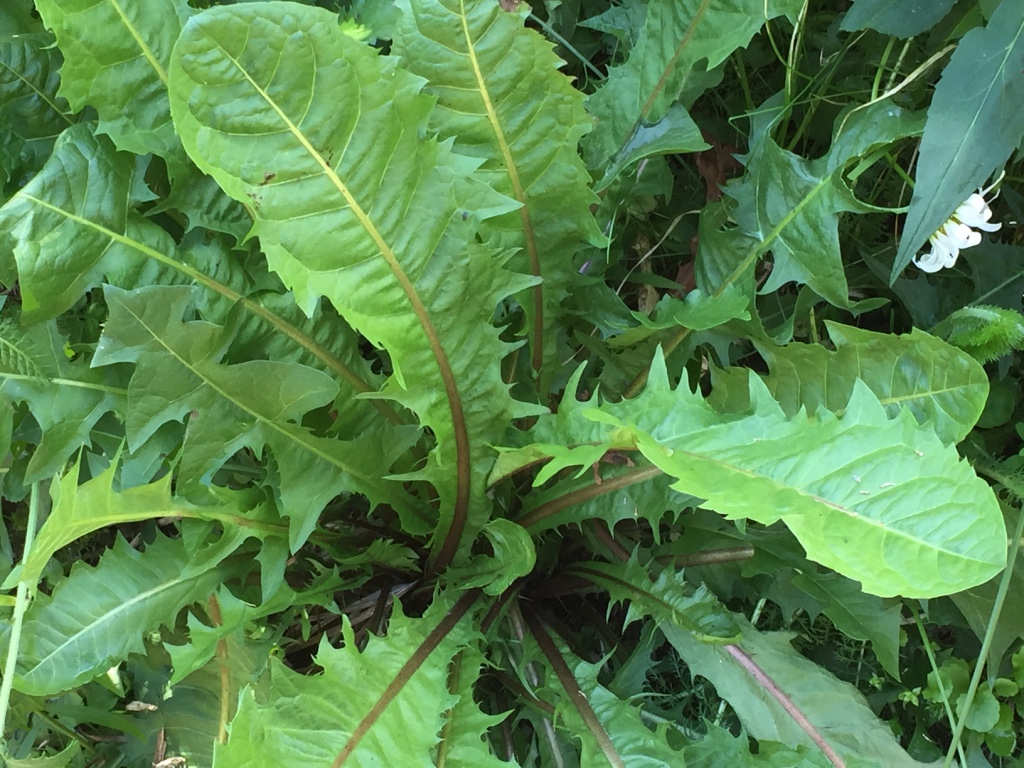
Dandelion For The Liver
Dandelion shines in its role as herbal support for the liver as a digestive bitter and alterative. David Hoffmann (2003) calls dandelion “a most valuable general tonic and perhaps the best widely applicable diuretic and liver tonic” while Matthew Wood calls dandelion a “spring tonic” and “blood purifier” (Wood, 2008). On an energetic level dandelion is cooling and is indicated for hot, congested conditions lodged in deep tissues (Wood, 2008).
The mildly bitter taste of the leaves signals bitter taste receptors on the tongue and throughout the digestive tract (Masé, 2013). In nature, the bitter taste is often associated with plant chemicals that are toxic to insect and mammal predators, so humans have evolved to detect these bitter tastes, which then stimulate the digestive and eliminatory processes needed to remove them from the body (Masé, 2013). Edible bitters like dandelion greens do not pose a threat to us but do serve to stimulate the production of saliva, digestive enzymes, and bile, thus improving digestion, absorption, and elimination. European folks have traditionally eaten dandelion greens in the spring (Wood, 2008) to “cleanse” the digestive system after a long winter of heavy foods.
Dandelion root is used for its alterative action to cool inflammation, thin fluids, and cleanse the liver, gallbladder, and pancreas (Wood, 2008). Dandelion is both choleretic, increasing bile production in the liver, and cholagogue, causing the gallbladder to release bile (Wood, 2008) into the small intestine and aid in the digestion of fats. Be aware that due to its gentle improvement of bile flow, dandelion acts as a mild laxative (Tillotson, 2001). As herbalist David Hoffmann (2003) writes, “as a hepatic and cholagogue, dandelion has an affinity for the liver, stimulates the gallbladder, and is helpful for relieving inflammation and congestion of both organs.”
Herbalist Kiva Rose describes alterative herbs as those that “restore function to the body by way of the metabolism, through increasing both eliminative functions and also through increasing the absorption of nutrients” (Rose, 2008). In its role as an alterative, dandelion supports the liver in removing metabolic wastes and hormones from the blood and encourages elimination, thus helping to clear eruptive skin conditions such as acne and eczema and supporting hormone balance.
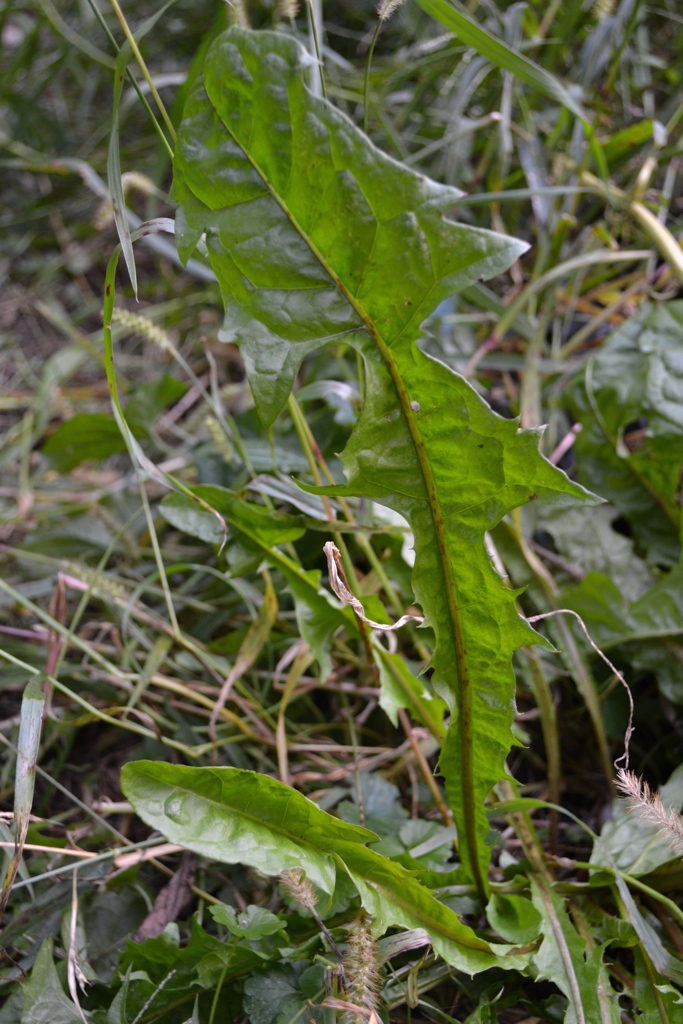
Dandelion For The Kidneys
Dandelion leaf stimulates the kidneys, increasing diuresis and encouraging proper elimination of uric acid, thus clearing out metabolic wastes. This is helpful in the case of water retention, gout, arthritis, and rheumatism, for example. Dandelion’s high potassium and other mineral content offset the resultant potassium and mineral loss through the urine (Hoffmann, 2003).
Dandelion For The Gut
As mentioned above, fall-harvested dandelion root is excellent nourishment for the body’s beneficial gut microorganisms. Known as a prebiotic, inulin is an indigestible carbohydrate that feeds gut bacteria such as Bifidobacterium and Lactobacillus, optimizing digestive function and crowding out other harmful bacteria (Murray & Pizzorno, 2005). Inulin may also help stabilize blood sugar levels (Murray & Pizzorno, 2005). This prebiotic herbal electuary made with fall-harvested dandelion root is a nice way to introduce more inulin into the diet.
Start Building your Materia Medica with these free pages!
Get to know dandelion firsthand – observe it growing in your yard (or just as likely through a sidewalk crack!), research its traditional use, and try some of the recipes linked in this article!
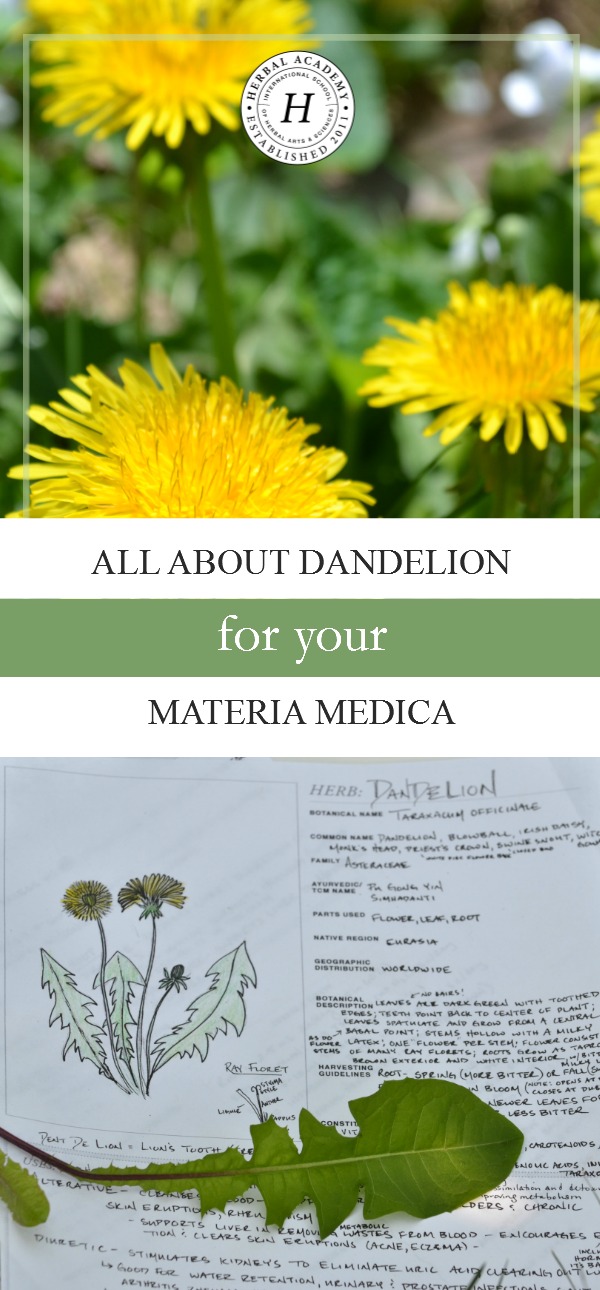
REFERENCES
Blair, K. (2014). The wild wisdom of weeds. White River Junction, VT: Chelsea Green Publishing.
Edible Wild Food. (n.d.). Sow thistle. Retrieved from http://www.ediblewildfood.com/sow-thistle.aspx
Hoffmann, D. (2003). Medical herbalism. Rochester, VT: Healing Arts Press.
Johnston, B. (2010). A close-up view of the wildflower “Dandelion” (Taraxacum officinale). Retrieved from http://www.microscopy-uk.org.uk/mag/indexmag.html?http://www.microscopy-uk.org.uk/mag/artjun10/bj-dandelion.html
Masé, G. (2013). The wild medicine solution. Rochester, VT: Healing Arts Press.
Murray, M. & Pizzorno, J. (2005). The encyclopedia of healing foods. New York, NY: Atria Books.
Pedersen, M. (2010). Nutritional herbology: A reference guide to herbs. Warsaw, IN: Whitman Publications.
Phys.org. (2016). The dandelion uses latex to protect its roots against insect feeding.
Retrieved from https://phys.org/news/2016-01-dandelion-latex-roots-insect.html
Rose, K. (2008). Terms of the trade 2: Alteratives. Retrieved from http://bearmedicineherbals.com/terms-of-the-trade-2-alterative.html
Tilford, G.L. (1997). Edible and medicinal plants of the West. Missoula, MT: Mountain Press Publishing Company.
Tillotson, A.K. (2001). The one earth herbal sourcebook. New York, NY: Kensington Publishing Group.
Virginia Tech. (1997). Virginia Tech weed identification guide: Common catsear or false dandelion. Retrieved from https://oak.ppws.vt.edu/~flessner/weedguide/hryra.htm
Weed, S. (1989). Healing wise. Woodstock, NY: Ash Tree Publishing.
Wood, M. (2008). The earthwise herbal: A complete guide to old world medicinal plants. Berkeley, CA: North Atlantic Books.







